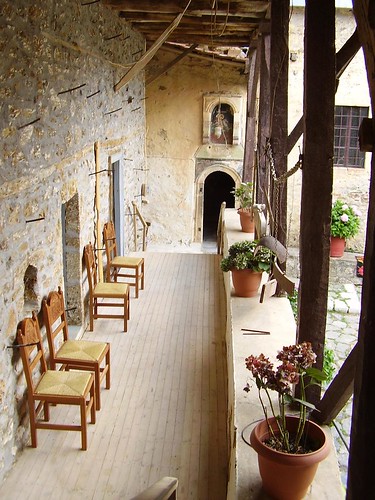
I just got a job (yay!), but it's a temporary one and requires me to be at work at 7:00 AM (boo.) It's at an archaeological project at Playa Vista, a development down by the ocean. More about the job later, but for now here's one of the ways I cope with having to wake up at the ass-crack of dawn. I bake a batch of these muffins on the weekend, and bingo, instant breakfast for the whole week. They're hearty and filling, and easy to eat as you're out the door and sprinting to the bus stop at 5:45 AM.
I like to freeze the muffins- they thaw really quickly in the microwave or in the toaster oven and taste like they're fresh out of the oven.
Bran muffins (adapted from this recipe, itself adapted from The New York Times Natural Foods Cookbook [1971]).
makes 1 dozen muffins.
1 1/2 cups oat bran
2 cups white whole wheat flour
3/4 tsp salt
1 1/4 tsp baking soda
2 tbsp brown sugar
1 tsp cinnamon
2 tbsp butter, melted and cooled
2 cups whole-milk yogurt
1 egg
1/4 cup honey
1/4 cup molasses
1 tsp vanilla
1/2 cup dried cherries (or more, up to 1 cup), and/or 1 large tart apple, peeled, cored & diced.
1. Preheat oven to 425 F. Grease muffin tin or line with paper muffin cups
2. Mix bran, flour, salt, baking soda, sugar, and cinnamon in a large bowl.
3. In another bowl, mix yogurt, melted butter, egg, honey, molasses, and vanilla.
4. Dump wet ingredients into the flour mixture, stirring only until just combined. Lumps are fine, but overmixing will lead to dense, chewy muffins. Fold in cherries.
5. Fill muffin tin with batter- this recipe makes a lot of batter and the muffin tins will be filled all the way to the top.
6. Bake for 15-20 minutes, or until muffins are golden and a toothpick inserted into the center comes out clean. Cool on rack.
September 25, 2007
Early morning bran muffins
Posted by
Maddy
at
8:34 PM
1 comments
![]()
September 21, 2007
Grown-up Fig Newtons (plus a bonus tart): SHF 35
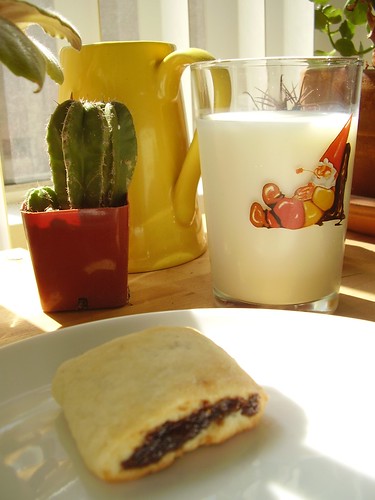
I admit, I've never tried a fig before, not intentionally anyways. I'm kind of a picky eater- as a kid, the only fruit I would eat were apples (preferably in sauce form or dipped in caramel), and it wasn't until I got a job at a Whole Foods Market after college and was encouraged to try all sorts of new fruits and vegetables that this started to change. I'm still striving to widen my culinary horizons- so when Ivonne at Cream Puffs in Venice announced that the theme of this month's Sugar High Friday was "figs", I took this as an opportunity to try something new.
You won't find any dramatic conversions here, though. I change in baby steps. So thinking about figs, I decided that the most logical thing to do would be to create something similar to one of my favorite childhood cookies, the Fig Newton (I didn't realize they had fruit in them back then, or my picky elementary-school self certainly wouldn't have eaten them).
I used a recipe for cuccidati (Italian fig cookies) from Gourmet magazine, which you can find here. I altered the recipe quite a bit, but I'm not going to publish my version of it just yet. It still needs a bit of ironing out, as you can tell from the series of mishaps that follows. So here's what I did:
-I omitted the nuts, because I don't like 'em.
-I didn't have any brandy, so I substituted orange juice
-I combined all the ingredients and then tried to grind them in a blender-- um, I don't recommend this unless you want to spend a half hour cleaning fig goo out of the nether regions of your blender. A food processor would have been ideal, but I don't have one. In the future, I would just chop the figs and raisins very finely.
-I added about 3 ounces of chopped dark chocolate.
-I realized too late that by omitting the nuts, I lost a full 1.5 cups of dry ingredients and my filling wound up being way too liquidy. I would say if you plan on omitting the nuts as well, cut back on the brandy/OJ and honey (the filling was really sweet anyways, so reducing the honey probably wouldn't hurt).
-Rolling out the dough and shaping the cookies was tricky. The key is to make sure the dough is well-chilled and not to put too much filling in the logs.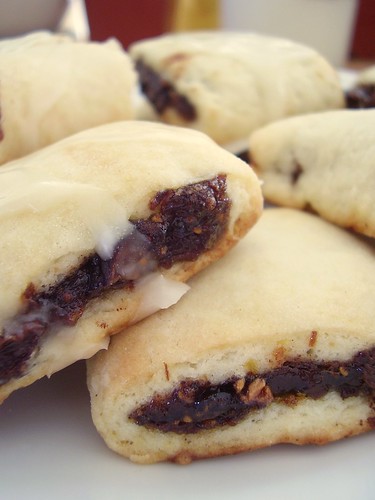
The finished product? Very tasty, but intense. The chocolate was a nice addition, but was overwhelming at times and I would add less next time (1.5-2 oz). I would probably make these again during the holidays- they do kind of scream "Christmas" (to me anyways) with all the cinnamon and cloves and orange. I did put the glaze on a few of them, but that made them too sweet for my taste.
I may even try this recipe again without the spices, when I want something more like a plain old Fig Newton.
I had some dried figs left over, and decided to make them into tarts. I made a fig jam using this recipe (I rehydrated the figs first, and added some extra water during cooking). The procedure for the tarts is fairly simple- make a tart crust of your choice (I used the almond sweet tart dough from Baking with Dorie), press into tart pan, top with jam, decorate if you so desire, then bake at 400 F until done (about 15 minutes for my mini-tarts). In the end, I actually liked these better than the cookies. So, that's one small step for me towards trying something new. Will I ever work up the courage to try fresh figs? Stay tuned!
So, that's one small step for me towards trying something new. Will I ever work up the courage to try fresh figs? Stay tuned!
September 18, 2007
Pumpkin Scones
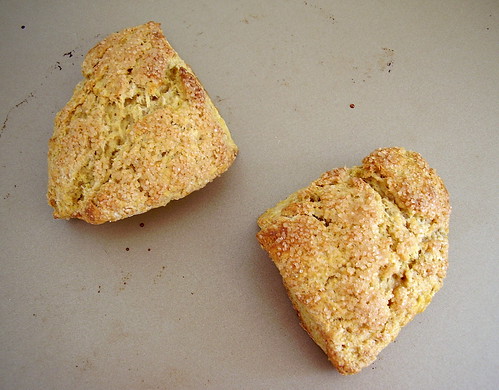
It's only September, and I've already began to crave all things pumpkin. When I saw Johanna's pumpkin scones on the Sugar High Friday #34 round-up, I was immediately sold, loving both pumpkin and scones. They're quite good on their own, but I decided to "Americanize" a batch of these traditional Australian treats them by sweetening them a bit and adding pumpkin pie spices (my apologies to Australia for messing with a good thing). So try the original version here, or try my bastardized American version below- both are very good in their own way.
Pumpkin Scones
Makes 6 giant or 12 smaller scones.
2.5 cups all-purpose flour
1 tbsp baking powder
1/2 tsp salt
1 tsp cinnamon
1/4 tsp ground cloves
1/4 tsp ground nutmeg
4 tbsp sugar
5 tbsp butter, chilled and cut into cubes
1/2 cup pumpkin puree (not pie filling)
1/2 cup milk
1. Preheat oven to 425 F
2. Mix together flour, baking powder, salt, cinnamon, cloves, nutmeg, and sugar in large bowl.
3. Cut butter into flour mixture with fingertips or pastry blender until mixture resembles coarse meal, with chunks of butter no larger than peas.
4. Mix together pumpkin and milk in a separate bowl, then add to flour/butter mixture. Stir until dough forms a shaggy mass, being careful not to overmix (dough should be a little dry, but if it's really not coming together add 1 or 2 more tablespoons milk).
5. Turn dough out onto floured work surface and knead a few times until a cohesive ball of dough is formed. Either roll dough out 3/4 inch thick and cut with biscuit cutters, or (even easier), form dough into 2 disks, 3/4 inch thick, and cut each disk into 6 wedges. If you want larger scones, form dough into one big disk and cut it into 6 wedges.
(*optional: at this point if you want you can brush the tops of scones with milk and sprinkle raw sugar on them for extra sparkle and sweetness*)
6. Bake at 425 F until very lightly browned, about 12-15 minutes for small wedges (larger scones will take up to an additional 10 minutes).
7. Cool on rack.
Posted by
Maddy
at
3:48 PM
3
comments
![]()
September 14, 2007
Roast Hedgehog, anyone?
Here's a fairly interesting news item about the cuisine of Ancient Britain, dating back to 6,000 B.C. It's a fun piece, but I'd be interested to know who the "food experts and archaeologists" are that they talked to and what their sources were. There's actually quite a bit you can say about the diets of ancient cultures based on archaeological evidence (fossilized seeds and pollen, burnt food left on cooking vessels, etc), although I'm not sure where they got these "8000 year old" recipes, given that writing did not yet exist in Britain at that time, or anywhere else for that matter.
Traditional English Cooking: nettle pudding and other ancient recipes, via the Daily Mail.
Anyone daring enough to take on the recipes? The garum sounds pretty tasty.
Posted by
Maddy
at
3:51 PM
0
comments
![]()
Labels: archaeology, misc.
September 13, 2007
It's here!!

What is this monstrosity, you ask? Why, it's a Waring Ice Cream Parlor, circa god-only-knows -when, and I couldn't be more excited.
An ice cream maker has always been on my list of to-get kitchen appliances, but not a priority due to the space constraints in my, um, cozy kitchen. But when my mother told me, "You know, I have your grandparents' old ice cream maker down in the basement, and I'm never going to use it - do you want it?" --how could I say no? (My boyfriend is torn about this new development, being simultaneously excited by the prospect of ice cream on-demand, but already fretting about where we're going to put the damn thing).
One of my favorite childhood memories is making ice cream with my grandfather. He had a fantastic wooden hand-cranked ice cream maker that he would always bring to our family 4th of July gathering. We would smash up ice in a burlap sack with a hammer, and then pour it along with a ton of rock salt into the machine. Into the canister would go the cream and vanilla, and after we cranked the machine for what seemed like hours, we were rewarded by a bowl of very soft, very delicious vanilla ice cream.
I'm pleased that I now have access to the pleasures of homemade ice cream without all the manual labor. The Waring is of the old-fashioned variety of ice cream maker, with the ice and the salt and a motor so loud it sounds like you're running a leafblower in your kitchen. Yes, I know that I could have easily bought a newer, possibly better ice cream maker for about the same amount of money as it cost my mom to ship it to me, but frankly that would have been far too logical.
And now, it's time to make some ice cream. This could be the beginning of a very dangerous friendship...
Posted by
Maddy
at
2:14 PM
2
comments
![]()
September 10, 2007
Sourdough Biscuits

My sourdough starter is driving me nuts. It sits in the back of my fridge, all docile and unassuming, I feed it every few weeks, and it seems happy enough. But when I try to bake with it...it suddenly turns into a temperamental, unpredictable mess, like a petulant 7-year-old throwing a temper tantrum. Sometimes it will foam up and overflow out of the bowl within a few hours, sometimes...nothing. Sometimes the bread I make from it will be perfectly edible but taste nothing like sourdough, while sometimes it becomes mouth-puckeringly sour. But it's hearty, though, I will give it that. I left it unfed for two months this summer, and I thought it was dead for sure. But lo and behold, there was still a glimmer of life, and now it's up to its old tricks.
One of the problems with a starter is that it needs to be fed every so often (2 weeks in my case, but some people feed theirs more often), and this feeding leaves a certain amount of excess starter, which can either be used in baking or discarded. As much as I like sourdough bread, I don't have the time (or masochistic personality) to bake it that often, and so I am more often than not left with a cup of starter that I eventually, regretfully, throw in the trash.
This recipe is a great way to use that extra cup of starter. The biscuits turned out light and fluffy, with a pleasant yeasty taste. Mine were in no way sour, although that could just be my unpredictable starter up to its old tricks. And they stay soft and tender for longer than regular biscuits- I accidentally left them sitting out overnight, and they were still surprisingly soft and edible in the morning.
Sourdough Biscuits
Makes 8-12 biscuits.
1 cup flour
1/4 tsp salt
1/2 tsp baking soda
2 tsp baking powder
1/4 cup (half a stick) butter, cold and cut into cubes
3/4 cup refreshed sourdough starter ***
1. Preheat oven to 425 F
2. In a large bowl, mix flour, salt, soda, and baking powder.
3. Cut butter into flour mixture using a pastry blender or fingertips, until mixture resembles coarse meal and bits of butter are no larger than peas.
4. Stir in starter. Do not overmix- stir only until mixture comes together. It will still look a little dry.
5. Dump mixture onto floured board and knead a few times until dough forms a cohesive mass. Roll dough about 1/2 to 3/4 inch thick, then cut out rounds with a biscuit cutter and place on baking sheet. Gather extra dough into ball, then repeat rolling and cutting.
6. Bake for 10-14 minutes, or until tops are lightly browned. Cool on rack.
***How much starter you will need depends on the consistency of your own starter- mine is very liquidy, so if yours is a bit thicker, you may need a little more to get a workable dough.
Posted by
Maddy
at
10:14 PM
4
comments
![]()
September 9, 2007
Greek Honey

I am a honey fanatic, and luckily for me, Greece is a great place to find great honey. Unlike, say, its wine, Greece's honey has an excellent reputation. The history of honey production in Greece is a long one and may even extend before the advent of written records, although there is little archaeological evidence to support this. Bronze Age Mycenaean (15th-12th centuries BC) tablets tell of the trade of jars of honey, but not of its production. One of the first written mentions of beehives is this charmingly misogynistic passage from Hesiod's Theogony (an 8th century BC poem about the birth of the gods) in which he compares women to drones, getting fat off the hard work of others:
"And as in thatched hives bees feed the drones whose nature is to do mischief -- by day and throughout the day until the sun goes down the bees are busy and lay the white combs, while the drones stay at home in the covered skeps and reap the toil of others into their own bellies – even so Zeus who thunders on high made women to be an evil to mortal men, with a nature to do evil." (Theogony 594-599, trans. H.G. Evelyn-White)
In the 5th century BC and later, archaeological evidence shows that bees were kept in ceramic beehives-- large pottery jars in which the interior had been incised before firing to provide a rough surface for the bees to attach the combs.
Honey production is still a major part of Greek agriculture, and we encountered plenty of beehives while doing our archaeological survey there. Greek honey is also, unfortunately, quite expensive (as honey tends to bee in most parts of the world, I suppose). My absolute favorite type of Greek honey is pure thyme honey- its flavor is amazingly floral and complex. It is also the most expensive type of honey- 12 Euros for a little jar in one store...in retrospect maybe I should have bought some, as it is very difficult to find here, and sooo good.
The honey pictured above was the only jar I brought home for myself on this trip. Its flavor can pretty much be summed up in one word: SWEET! The sweetness hits you like a truck but fades fast- there's not much depth of flavor here. Still, very nice on toast, and I 've yet to meet a honey I didn't like.
For more information on the history of honey production in Greece and elsewhere, see The World History of Beekeeping and Honey Hunting, by Eva Crane. Taylor and Francis, 1999.
Posted by
Maddy
at
2:30 PM
4
comments
![]()
September 7, 2007
Greek Wine, Rose Jam, and Pigs: Travel in the Peloponnese
In case you're just tuning in, I'm describing my adventures this summer on an archaeological project in Greece--see the previous two entries for background. We worked at the site Monday through Saturday, with Saturday being a “half” day (we got off at 12:00, which hardly makes it a half day, really). Some weekends were spent relaxing on the beach or sleeping, but often we took the opportunity to travel.
On the second weekend of the project we journeyed into the mountains to the south of Sikyon, to the site of Nemea. We had worked a “half day”, from 6:00 AM to noon, then piled in to our rental cars and beat-up project trucks for the short journey to the site. On the way there, however, we made an important stop.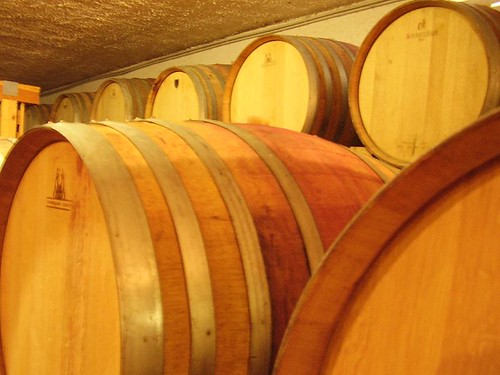
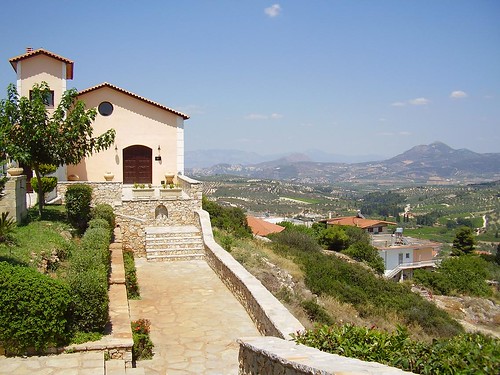
The Lafkiotis winery is located in Ancient Kleonai, not far from Nemea. Now, Greece, perhaps justly, does not have a reputation for good wine (quite the opposite in fact), but in reality there are many quality wines to be found if you look hard enough. Nemea is a region known for its wine production, which ranges from reputable wineries to homemade stuff sold in re-used water bottles on the roadside. And let me tell you, if you've never had homemade wine from an old water bottle...just don't.
Since our project director was a friend of the owners of Lafkiotis winery, after a brief tour we were treated to a tasting of four different wines. At this point I was feeling a bit woozy, since I had just spent 6 hours working in the sun and hadn’t eaten any lunch…but how could I pass up a free wine tasting? We tried two whites and two reds, and while the whites were good, the reds were really outstanding (this coming from a white wine drinker). The reds were both Agiorgitiko, meaning that they were produced from a variety of grape that are unique to Greece, and had been aged in oak barrels for a year.
After the wine tasting, we stumbled back to the cars and were on our way to the site of Nemea. During the 6th and 5th centuries B.C., Nemea was home to a temple of Zeus and to famous athletic games, kind of like the Olympics, in which athletes would come from all over Greece to participate. The stadium has been pretty well preserved, and tourists can still run a footrace on it if they want. However, as we found out, unlike ancient Greek athletes, tourists cannot race in the nude and there is a guard on hand at all times to enforce this rule.
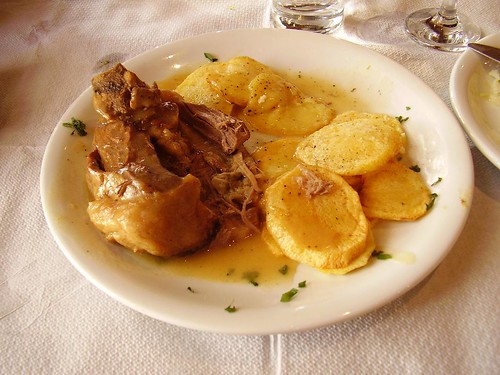
By this point it was 3:00 PM, and having toured the archaeological site in midday heat with nothing to fuel me but wine and some cookies I found in the car, I was fading fast. Thankfully, we at last sat down for lunch in a local restaurant, and my patience was rewarded with a nice hunk of lamb and some lemony potatoes. And more wine. Needless to say I didn't last long after this.

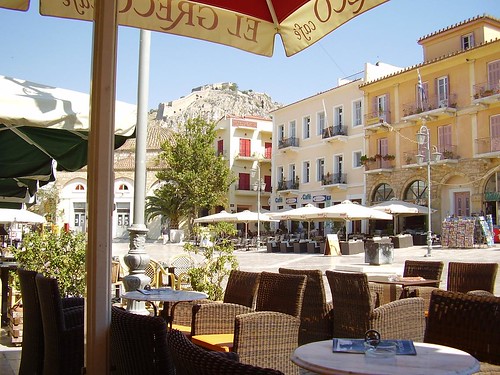


The next weekend it was off to Nafplio, a very nice town in the Argolid region of the Peloponnese. If you are ever in Greece, I highly recommend going to Nafplio. Once a Venetian stronghold, its old town is characterized by lovely Venetian architecture, two imposing fortresses, Turkish fountains, and a large, open plaza where locals and tourists gather in cafes for an afternoon frappe and some people-watching. Add to that decent restaurants and some nice beaches nearby, and you’ve got yourself a great place to spend a weekend.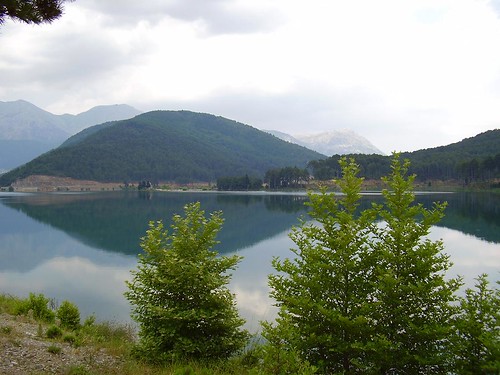 I’m going to cheat a little and tell you about a trip we took last year to Stymphalos, which, if you remember your Greek mythology, is home to the Stymphalian birds…you know, the ones that Hercules fought as one of his twelve labors…not ringing any bells? In any case, the site is located in a swampy area in the mountains of Arcadia, and doesn’t see a lot of tourists, which is a shame because Arcadia is a lovely place- mountains, orchards, marshes, the kind of place where it suddenly doesn’t seem so implausible that gods were born here and nymphs inhabit the landscape.
I’m going to cheat a little and tell you about a trip we took last year to Stymphalos, which, if you remember your Greek mythology, is home to the Stymphalian birds…you know, the ones that Hercules fought as one of his twelve labors…not ringing any bells? In any case, the site is located in a swampy area in the mountains of Arcadia, and doesn’t see a lot of tourists, which is a shame because Arcadia is a lovely place- mountains, orchards, marshes, the kind of place where it suddenly doesn’t seem so implausible that gods were born here and nymphs inhabit the landscape.
Before making our way to Stymphalos, we stopped at a gorgeous mountain lake for a swim, then headed up to a monastery perched high on the mountain above. The monastery was several centuries old and looked its age, but there were still a few monks living there. When we entered the monastery we were greeted by a monk who offered us cold water and spoonfuls of their monastery’s special product, rose-petal jam-- made from just rose petals, sugar, and water, it was shockingly sweet but very tasty, the rose petals still fresh enough to be a bit crunchy.
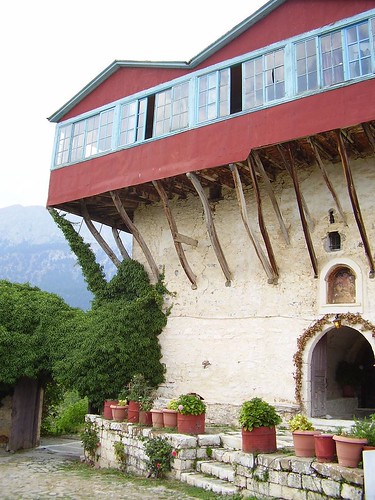
A few of us spent the night in the town of Stymphalos, known for its pig farms, the archaeological site, and not much else. Pork was the local specialty, slabs of meat from pigs that had been roasted whole over coals all day. A by-product of this and another local favorite was kokoretsi, grilled pig offal wrapped in intestine…needless to say, I was not adventurous enough to try this.
So much pork…and after a long night on the town in Stymphalos, there’s really nothing like walking out onto your hotel balcony and seeing this first thing in the morning:
See the other installments in this series:
- Part 1: Finally, Greece! (intro)
- Part 2: Greece (about the project)
- Part 3: A day in the life (daily life on the project)
Posted by
Maddy
at
12:36 PM
2
comments
![]()
Labels: archaeology, Greece, travel




